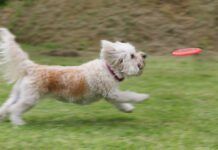It’s dinnertime, and you’ve put your dog’s filled food bowl on the floor in its normal place. A couple of minutes later, you walk into your bedroom and hear a crunch underfoot, only to discover pieces of kibble scattered everywhere, and your pup happily devouring it, piece by piece.
No, it’s not because your dog is suddenly terrified of his food bowl, or that he’d rather have a blue bowl than a red one, or that he just likes to make a mess. However, even researchers and dog behaviorists can’t say with absolutely certainty why some dogs exhibit this carrying-food-to-another-place behavior. The best these experts can offer are theories about why some dogs prefer to eat their food somewhere other than their food bowl.
As with so many dog peculiarities like digging, or licking, or circling before lying down, there’s general agreement that part of the answer lies in the domestic dog’s wolf ancestry. When the pack made a kill, the parents would feed first, after which the juveniles would have to compete for the best pieces, then drag them away to avoid having to fight the rest of the pack for them. “Fighting is obviously very risky,” explains Dr. Julie Albright-Keck with the University of Tennessee College of Veterinary Medicine, “so most animals, especially subordinate ones, will go to great lengths to avoid an altercation.”
A slightly different take comes from some experts who think that dogs who feel chronically vulnerable or who exhibit a lower social status could be more motivated to carry their food to a different place so no other dog can get to it—even if they’re the only dog in the home. Again, this could be related to the tendency among the dog’s wild ancestors for young or more passive members of the pack to grab their share of the kill, then take it somewhere else to guard it from competitors. “Even though a domestic dog may not be in danger when eating, it may be that instincts override everything else,” explains veterinary health expert Dr. Gary Richter.
This food-moving behavior doesn’t appear to be associated with specific breeds. While some studies show that smaller dogs do this more than larger dogs—many going so far as to carry their entire food bowl elsewhere—other experts have found that more wolf-like dogs such as Siberian Huskies, Malamutes, and Great Pyrenees also tend to take their food to other places to eat it.
Another theory is that some dogs may take their food to another place to eat it because of the desire for companionship. We know that wolves hunt and eat in a pack, and there’s a chance that your dog wants its “human pack” with him while he eats. “By nature, dogs are social creatures and the company can motivate them to eat,” says canine behavior expert and trainer Shelby Semel.
Dr. Liz Stelow of the University of California Davis School of Veterinary Medicine echoes this sentiment, explaining that the reason some dogs want companionship at mealtime may be because they receive an emotional reward for eating. “Some owners create a relationship with the dog around food,” she says, “especially if he has a history of being a picky eater.” Over time, the dog has come to expect—and enjoy—his caretaker’s verbal encouragement, possible hand-feeding, and general attention. This can lead to the dog feeling more rewarded by eating in the caretaker’s presence than alone.
Another possible reason your dog might be taking food from his bowl is the bowl itself. “If you’re feeding your dog from a metal bowl,“ explains Dr. Holly Ahlgrim, Urgent Care veterinarian at the Animal Medical Center of Seattle, ”it’s possible that the clinking sound created by food being pushed around, or a dangling collar tag, may be irritating or upsetting your dog. They may be chewing their food away from the bowl to avoid the sound.”
A related issue is the dog who, contrary to taking his food somewhere else to eat it, won’t let anyone near it. It’s a perfectly normal canine behavior to protect a food source, since in the wild, food protection behavior evolved to keep other dogs away from a meal. Even though in most cases the modern family dog doesn’t really need to protect his food from a scavenger, this behavior is innate, harkening back to the dog’s past as a wild animal. This is related to a behavior called caching, where an animal hides or buries a food resource to save it for the future.
But even in wolves, food guarding is less often actual aggression than it is a threat display. This can include growling, baring of teeth, or snapping and while this kind of behavior can be disturbing to us, it seldom results in a bite. In a study of 3,226 dogs, 41 percent of the dogs showed vocal behaviors towards humans during resource guarding, but only 15 percent escalated to biting, and of those, less than 10 percent caused an injury. Regardless, any time a dog exhibits this type of threat display, you need to be extremely careful in your approach to avoid being bitten. If you are at all uncertain of how to address this issue, consult with a qualified behaviorist.
One other strange behavior some dogs exhibit around food is covering the food bowl. Veterinary researcher Dr. Myrna Milani explains that most of the time, the dog that tries to hide their food—whether with a blanket, a pair of socks, or anything else they can find—is uncomfortable with something in their immediate environment that makes them not want to eat at that specific time or in that specific place. “If an animal doesn’t feel secure in its space it won’t eat, no matter how tempting the food you offer it,” she says. Any number of things can spark that insecurity, including an unfamiliar human or other animal nearby, unusual activity in the home, or even a change in where the dog is being fed. If this behavior happens often, it’s worth doing some detective work to figure out what’s bugging your pup.
In the end, if your dog decides to transport his kibble to the living room to eat it, the worst case scenario is that you step on an errant pellet and have to clean it up. But other than that, there’s nothing to worry about: it’s perfectly normal, if a little exasperating, dog behavior!






